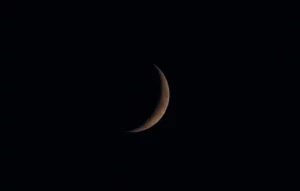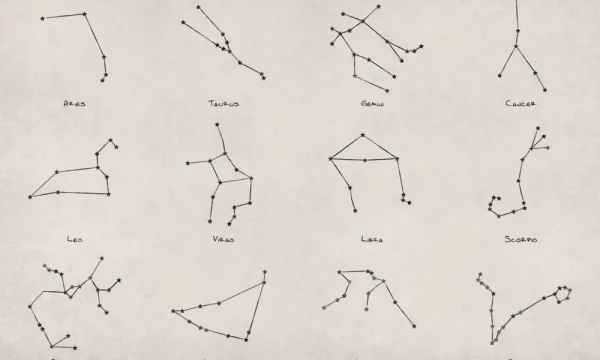
The 12 Zodiac Constellations in The Night Sky
Last Updated: November 20, 2023
While stars in general fascinate us, since ancient times we have drawn pictures in the night sky by connecting these shining dots and linking them to stories. Each culture had its own set of constellations and myths, legends, or stories that went with them, but there is a group of constellations that have held a special place in our hearts for thousands of years. These zodiac constellations have impacted our cultures throughout the ages.
Introduction
The zodiac constellations lie along the path of the Sun known as the ecliptic or ecliptic plane. From our perspective, the Sun appears to “pass” through these constellations. Because of this, these constellations, even more so than the others, took a special place in our mythology and cultures including determining the time of year as well as coinciding with various festivals, rituals, and annual events. It is also important to note that the orbits of our planets (and therefore their moons) pass through this band as well.
Note: Many follow astrology, the study of astronomical bodies’ impact on our lives, using it to determine the interplay of people and even our future. This is different from astronomy which is the scientific study of the universe. For this article, we will be focusing on the astronomical focus of these constellations, not astrological.
One important feature to remember is that the astrological calendar relates to when the Sun passes through the constellation, which means they won’t be visible during the nighttime. In addition, over the 2,500 years, since these constellations and the astrological calendar were set up, the paths of the stars in our night sky have changed since the Earth wobbles a bit like top in its spin. Therefore, the times to view these constellations will not line up with the astrological calendar.
Before we delve into each one, let’s go over a few quick terms.
Constellation
One of the 88 distinct official groupings of stars that are connected to form a shape (made official by the International Astronomical Union in 1930 with boundaries). Of these, 50 are “ancient” constellations, bright and visible enough to be cataloged since ancient times most notably by Ptolemy in the 2nd century (note that the ancient constellation Argo was divided into 3 for the IAU list).
All of the zodiac constellations were cataloged by Ptolemy. Thirty-eight are considered “modern” as they were identified in the 1500s through the 1700s when telescopes were used to observe the night sky in the Southern Hemisphere by Europeans.
Note: All stars fall within the boundaries of one of the 88 constellation regions, but not all stars make up the shapes of our constellations.
Asterism
A group of stars that connect to form a shape that is not one of the 88 official constellations; these are often parts of constellations and can sometimes be more widely known than the official constellation (i.e. the Big Dipper asterism in the Ursa Major constellation).
Magnitude
A measure of the brightness of an astronomical object in terms of how it appears from Earth, originally created by the early Greeks to rank the brightest stars in the sky to the dimmest. It is important to remember that this scale has lower numbers for brighter objects and higher numbers for dimmer ones, meaning some objects such as planets and moons are in the negatives.
While constellations used to hold a larger place in our cultural background, they have always been and continue to be used to navigate the night sky. Since the IAU’s list of constellations is internationally recognized, astronomers both professional and amateur use them to identify portions of the night sky. Each culture had its own set of constellations that were connected to their myths and legends, which the IAU pulled from, primarily from Greek, Roman, and ancient Middle Eastern astronomy.
So, without further ado, let’s explore the zodiac constellations including their features, stars, location in the sky, notable astronomical objects, and mythological tie-ins.
Capricornus “The Seagoat”
This constellation forms a vaguely triangular or arrowheaded shape in the night sky. It is a southern hemisphere constellation, representing a creature that is a blend of fish and goat, with the name meaning “goat” in Latin. It is typically referred to as Capricornus when referring to the constellation and Capricorn when referring to the astrological sign.
It is one of the faintest constellations and only the 40th largest, spanning 414 square degrees in the. It is often grouped with the other water constellations including the zodiacs. It borders Aquila, Sagittarius, Microscopium, and Aquarius. It can be seen in the northern hemisphere in early autumn.
Three stars (Alpha-2 Capricorni, Beta Capricorni, and Omega Capricorni) form a triangle to help mark this constellation. However, the brightest star, Delta Capricorni/ Deneb Capricorni/ Deneb Algedi, since Deneb is Arabic for tail, is in the tail of the seagoat with a magnitude of 2.91.
It is also used as a placemark for the tropic of Capricorn where the sun appears overhead at noon on the winter solstice.
Capricornus contains one Messier object, M30, which is a globular star cluster over 90 light-years across with over 100,000 stars 30,000 light-years from Earth. While it also contains a number of dim galaxies and star clusters, these can only be seen in large telescopes.
This constellation comes from the cultures of Sumeria and Babylonia who identified it as a mythical figure that was half goat and half fish and a goat-human hybrid. The Greeks associated this constellation with Pan who escaped the monster Typhon by jumping into the Nile, but was only half submerged, which turned half of his body into a fish. Another version of the myth associated this constellation with Amalthaea, the goat who was the foster mother to baby Zeus.
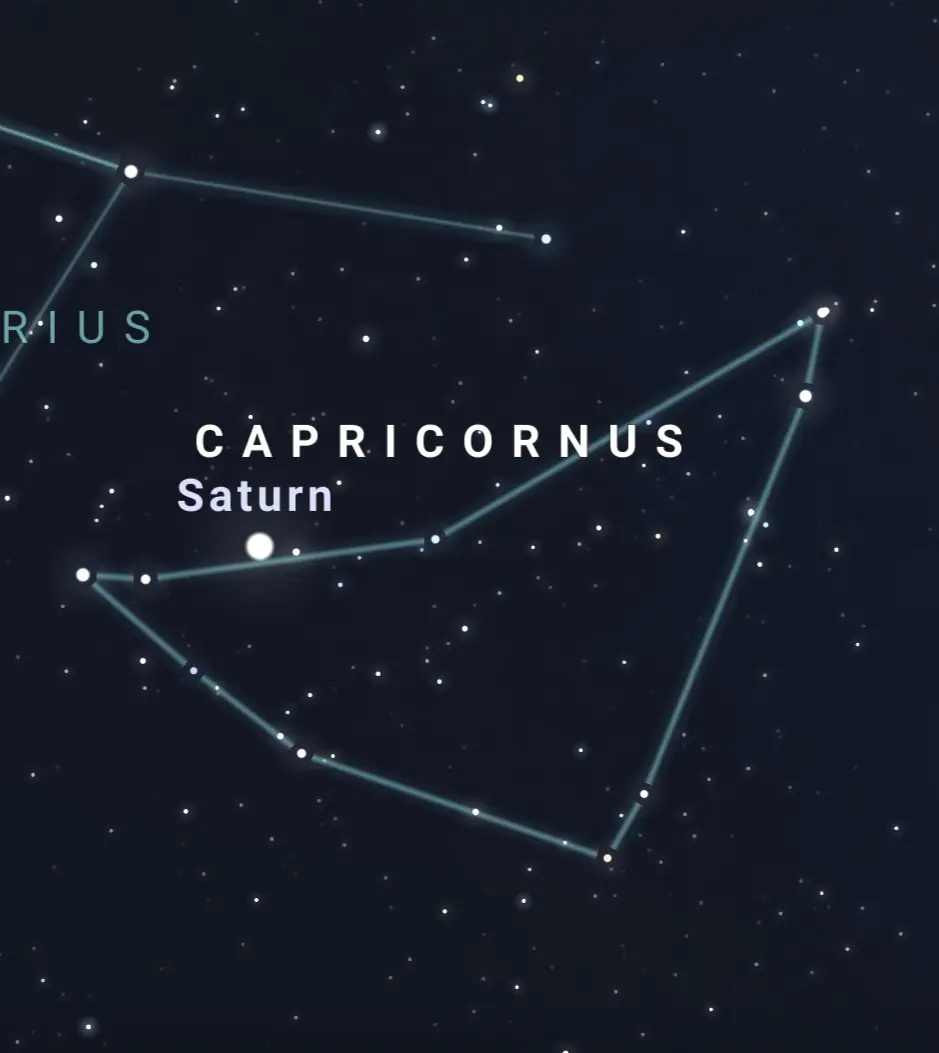
Aquarius “The Water Bearer”
Aquarius is a fairly large group of stars, the 10th largest constellation in the sky covering about 980 square degrees (taking up more than 2% of the night sky when visible!), but none are particularly bright, making it difficult to spy with the naked eye. It is visible in the spring in the Southern Hemisphere and fall in the Northern Hemisphere, located near other water constellations like Pisces (below), Delphinus, and Cetus. It is depicted as a man pouring water from a vase into the mouth of the constellation Piscis Austrinus, the Southern Fish.
The brightest star is the yellow supergiant (a rare star type) beta Aquarii, also known as Sadalsuud, at 2.91 magnitude followed by Sadalmelik with a similar magnitude of 2.96.
Aquarius contains three Messier objects:
- M2: a globular star cluster containing about 150,000 stars, making it one of the largest globular clusters known
- M72: another globular cluster about 53,000 light years from Earth
- M73: an asterism of four stars that appear close together in the night sky.
Aquarius also includes several planetary nebulas, best seen with a large telescope:
- NGC 7009/ the Saturn Nebula due to its shape in the approximate form of the ringed planet
- The Helix Nebula: one of the closest of all planetary nebulae, less than 700 light-years away
Aquarius also hosts Earth-like exoplanets such as in the Trappist-1 system which is only 40 light-years away from Earth. It contains one of the highest numbers of observed exoplanets, rocky Earth-like exoplanets, and exoplanets that lie in the habitable region of the star (where water could potentially exist in liquid form).
The Greeks linked Aquarius with Ganymede, the cupbearer to the gods (and a moon of Jupiter), or with how Zeus poured life-giving water onto the Earth. The annual rising of this constellation coincided with the rainy season in the Northern Hemisphere meaning many other cultures also associated this grouping of stars with water in some way including Chinese, Indian, Babylonian (the god Ea), Ancient Egyptian (the god of the Nile), and Arabic astronomy.
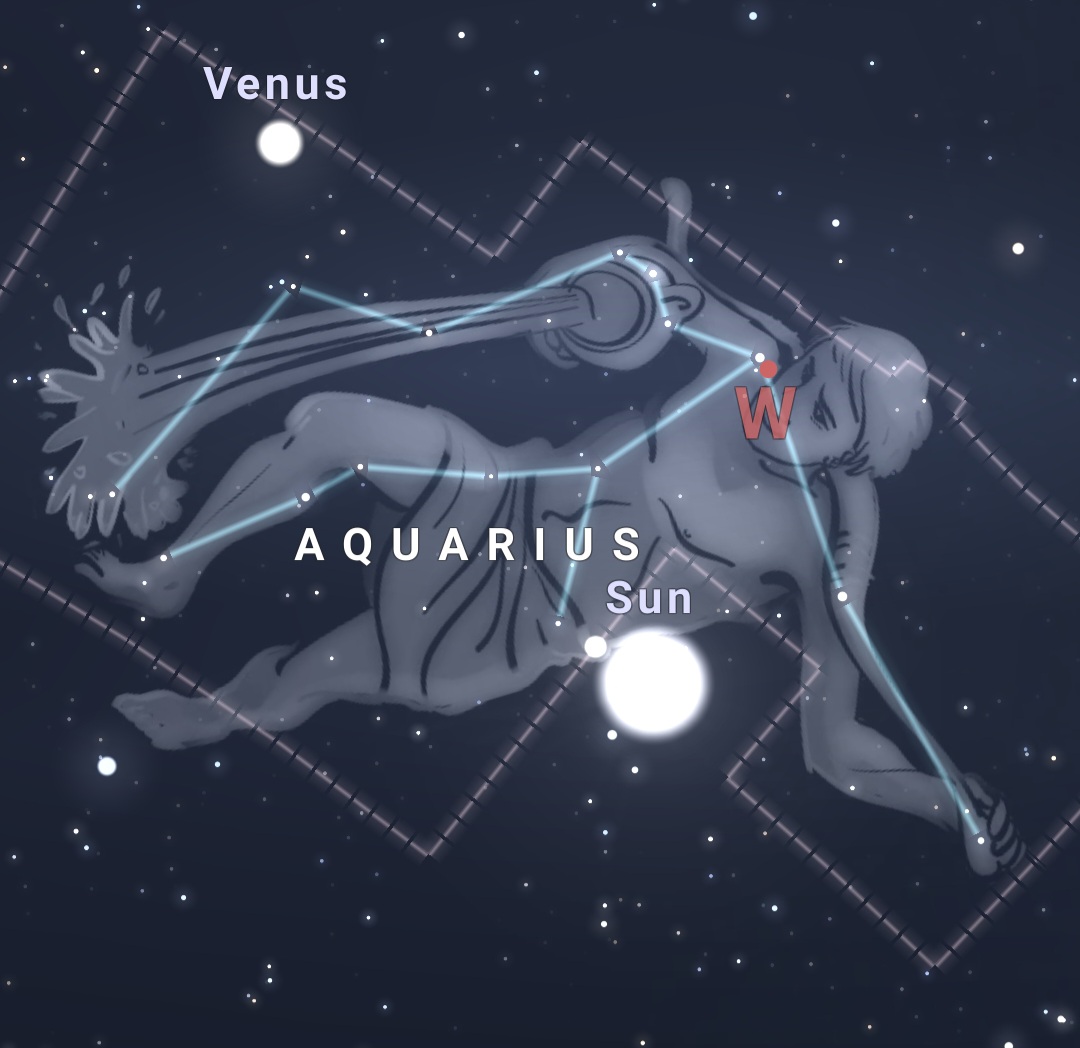
Pisces “The Fishes”
Pisces is another large constellation, occupying 889 square degrees, and the 14th largest constellation in the sky. While large, the stars are faint so it’s hard to spot with the naked eye. Pisces currently contains the point at which the Sun crosses the celestial equator into the Northern Hemisphere around March 20th every year, the vernal equinox.
It is visible in the night sky between October and December in the Northern Hemisphere. It covers a large V-shaped region in the first quadrant of the Northern Hemisphere and is located northeast of Aquarius and northwest of Cetus the sea monster or whale. One of the tried and true ways of finding this constellation is to find the Square of Pegasus and go South to the Circlet of Pisces, also known as the head of the Western Fish, and then find the other side, the Eastern Fish to the east of the Square.
While all the stars are particularly faint the brightest is Eta Piscium which is also known as Alpherg or Kullat Nunu “Cord of the Fish”, a giant star 316 times brighter than the Sun at 3.62 magnitude. Only two other stars, Gamma Piscium and Alrischa “The Well Rope”, are under 4 magnitude at 3.69 and 3.82 respectively.
Pisces contains Messier 74, a spiral galaxy 32 million light-years away with about 100 million stars, but larger telescopes are needed to view it like the other dim galaxies in this constellation. There is also evidence of a black hole in galaxy NGC 660 and several exoplanets have been found in the constellation including a super-Earth exoplanet called HIP 116454b.
Pisces is represented by 2 fish swimming facing opposite directions attached by a cord representing the Greek goddess Aphrodite and her son Eros. He turned into a fish and jumped into the Euphrates River to escape the monster Typhon.
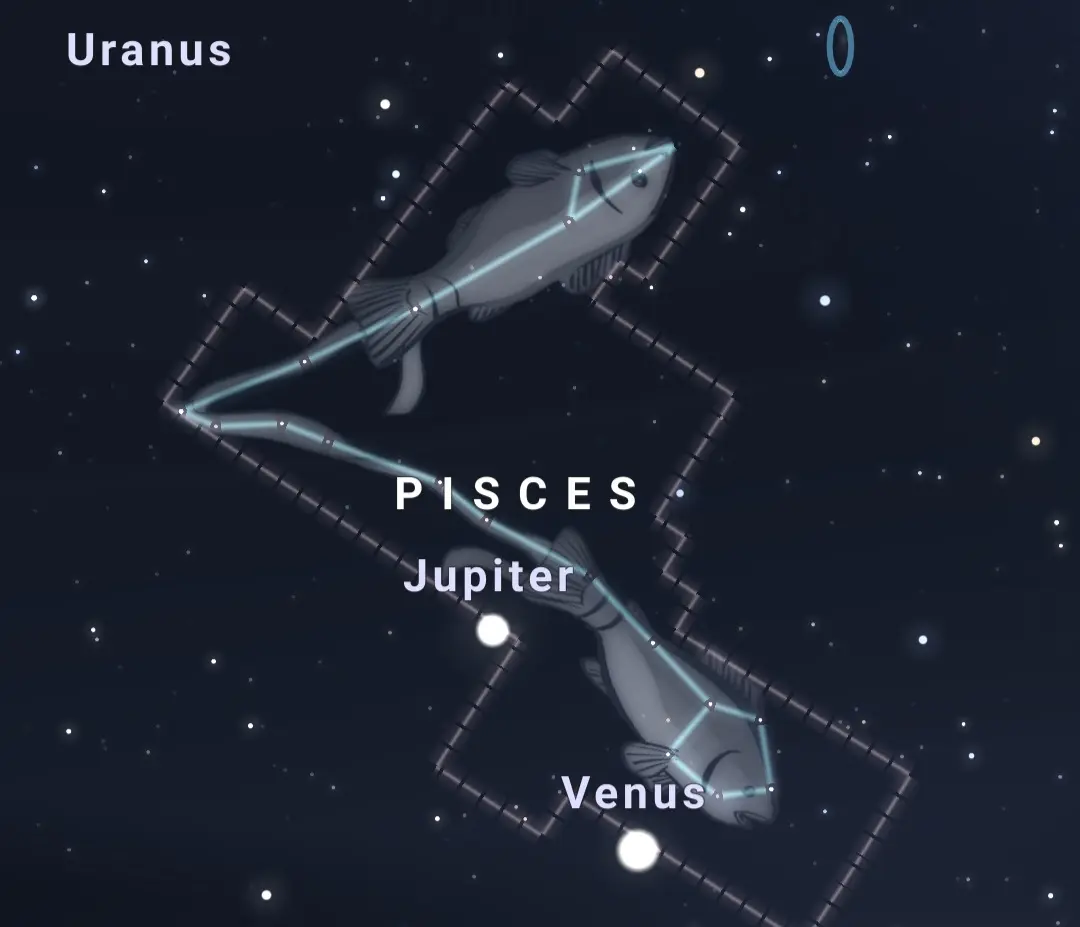
Aries “The Ram”
Aries is the 11th smallest of the zodiacs, at only 441 square degrees, and the 39th largest of all 88 constellations. It is Latin for “ram” and is bordered by Taurus, Pisces, and Cetus. It is best seen in the Northern Hemisphere in late winter and early spring.
Most of the stars are quite dim, making even the 4 brightest stars in a crooked line hard to spy or even invisible in light-polluted areas. The brightest, Hamal “Head of the Ram”, only has a magnitude of 2 while the next brightest Sheratan “The Two Signs” is at 2.64. It is also in a somewhat empty area of the sky, making it harder to “starhop” to.
Aries is in the northern sky, with the head between the Pleiades star cluster and Pegasus. In latitudes above the Tropic of Cancer, Aries will appear to travel to the south across the sky as the Earth spins. When planets are visible, they can be helpful in spying Aries as they will also lie on the ecliptic line. Fun fact: Hamal and the Sun used to be in conjunction on the spring equinox, but today this happens about a month later on April 24th.
There are not many deep sky objects in Aries, but there are a few including the Fiddlehead Galaxy (NGC 772) which is a spiral galaxy with one unusually long arm as it is being stretched by tidal interactions with a neighboring galaxy.
The annual Arietid meteor shower seems to originate from the Aries constellation, running from late May to Early July, peaking on June 7th typically. However, it’s unusual because it’s “invisible” due to the fact that while it’s highly active, it peaks during the daytime. Your best chance to see it is an hour before dawn during the peak.
It’s important to remember that Aries is not Ares, the Greek god of war. Instead, Aries is the ram with the golden fleece in the Greek myth of Phrixus, the Boeotian prince who was saved by a winged ram with golden fleece sent by Heracles (Hercules). Zeus honored the ram by placing it in the night sky. You may also know of the golden fleeces from the Greek myth of Jason and Argonauts. However, this ancient constellation was known in many forms across several cultures. The early Babylonians saw it as a farmhand while the early Chinese saw it as twin inspectors and the people of the Marshall Islands saw it as a porpoise.
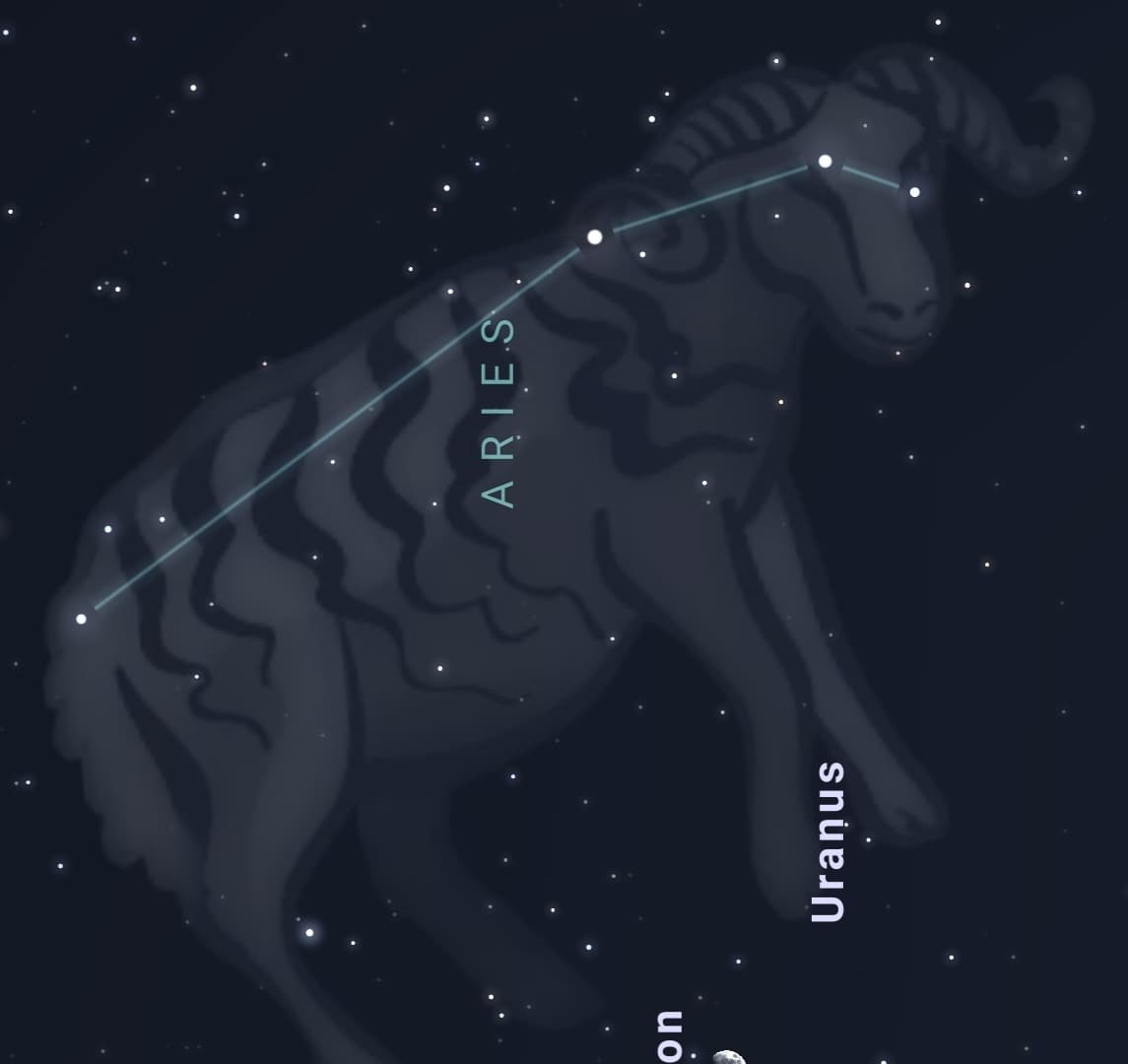
Taurus “The Bull”
Taurus is one of the most well-known and noticeable constellations in the sky primarily due to its size, bright stars in a distinctive V shape, one particularly bright different-colored star, and its close location to Orion.
As the 6th largest of the zodiac constellations, and the 17th largest constellation overall, it covers 797 square degrees, or 1.9% of the night sky. It was recognized by the Babylonians in the 5th century B.C.E. as a zodiac constellation and the first in its calendar, but observations of it date back to the Bronze Age, 15,000 years ago. Its conjunction with the Spring equinox meant it was greatly tied to agriculture in ancient civilizations including those in Sumer, Assyria, Babylon, Egypt, Greece, and Rome.
While it is currently named after the bull Orion fights (and therefore is next to him in the sky), it was known as the Bull of Heaven in the Akkadian Empire of Mesopotamia, a mythical beast sent to kill the hero Gilgamesh by the goddess Ishtar. The Egyptians believed the human race was created when the Sun had its vernal equinox here (no later than 4,000 B.C.E.) and associated this constellation with their gods Osiris and Isis. In addition to its connection to Orion, Taurus is often connected to two other Greek myths. In one, Zeus turned into a bull to lure and abduct Europa to make her his mistress. The other myth includes another of Zeus’s affairs, this time with Io who was eventually turned into a heifer to protect her from Zeus’s jealous wife Hera. Both Europa and Io were also immortalized as moons of Jupiter, the Roman version of Zeus.
This northern constellation is highest in the sky in the northern hemisphere around December and January, but visible in both fall and spring as well in both hemispheres between latitudes 90 degrees and minus 65 degrees. In fact, it is observable around the world at certain times of the year. The bull is traced out in a two-pronged fork of stars. The central “v” and Hyades Star Cluster make up the head. Many stargazers find it easy to find, especially using Orion’s belt to point up toward the red eye of Taurus, Aldebaran. Taurus is also neighbored by Aries, Auriga, Cetus, Gemini, and Perseus.
Taurus features multiple stars up to the fourth magnitude, essentially drawing out the figure of the constellation stickwork, but a very dark location provides the ability to see about 160 of them with the naked eye above magnitude six. Aldebaran, or Alpha Tauri, is the brightest star in Taurus and the 13th brightest star in the sky with a magnitude of 0.86. Over 300,000 years ago it was the brightest star in the sky when it was about 21.5 light-years away (it has since been moving away from us). It is a red giant star, which our own Sun will become when it uses up all the hydrogen for nuclear fusion. Aldebaran means “the follower” in Arabic, referring to the fact it follows the Pleiades star cluster across our night sky.
The Pleiades, also known as the Seven Sisters, is a star cluster within Taurus also known as Messier 45 and NGC 1432. Open star clusters are groups of stars that all formed from the same cloud of gas and dust. You can find the Pleiades by continuing to move up past Aldebaran to find a fuzzy group of stars. It has a magnitude of 1.6 and lies about 390 light-years from Earth. While 6 are visible to the naked eye, it is made up of about 500 stars and they are all relatively young, hot, blue stars. All the ones visible to the naked eye range from 2.86 to 6.41 in magnitude. The seven brightest are named after the daughters of Atlas, the titan who holds up the sky.
The Crab Nebula (Messier 1/ NGC 1952/ Taurus A) lies below the lower horn. This nebula is a remnant of a supernova six light-years wide. About 6,500 light-years from Earth, it has a magnitude of 8.4, making it bright enough to spot with a small telescope, especially in January.
The Hyades Cluster is another open star cluster making up the V-shaped asterism and is the second closest open cluster at only 150 light-years away. In contrast to the Pleiades, the stars in this cluster are older red giants and white dwarfs (the smoldering leftover cores of stars that have shed their outer layers), meaning they are around 600 million years old.
Taurus also has a number of galaxies within its borders, the brightest of which is the elliptical galaxy NGC 1587 with a magnitude of 11.7 located about 165 million light-years away. Taurus also contains the colliding galaxies NGC 1409 and NGC 1410 (together known as UGC 2821) about 300 million light-years from Earth.
The constellation contains at least 85 deep-sky objects, even though most are faint galaxies. Taurus is a common target for amateur astronomers and astrophotographers. Common wide-angle lenses can spy the Bull and neighboring constellations while longer focal lengths can spy some of the deep-sky objects such as 135-200 mm for both the Pleiades and Hyades clusters.
Taurus is also known for being the point of origin for the Taurids meteor shower every year between October and December when Earth passes through debris left over by Comet 2P/Enke.
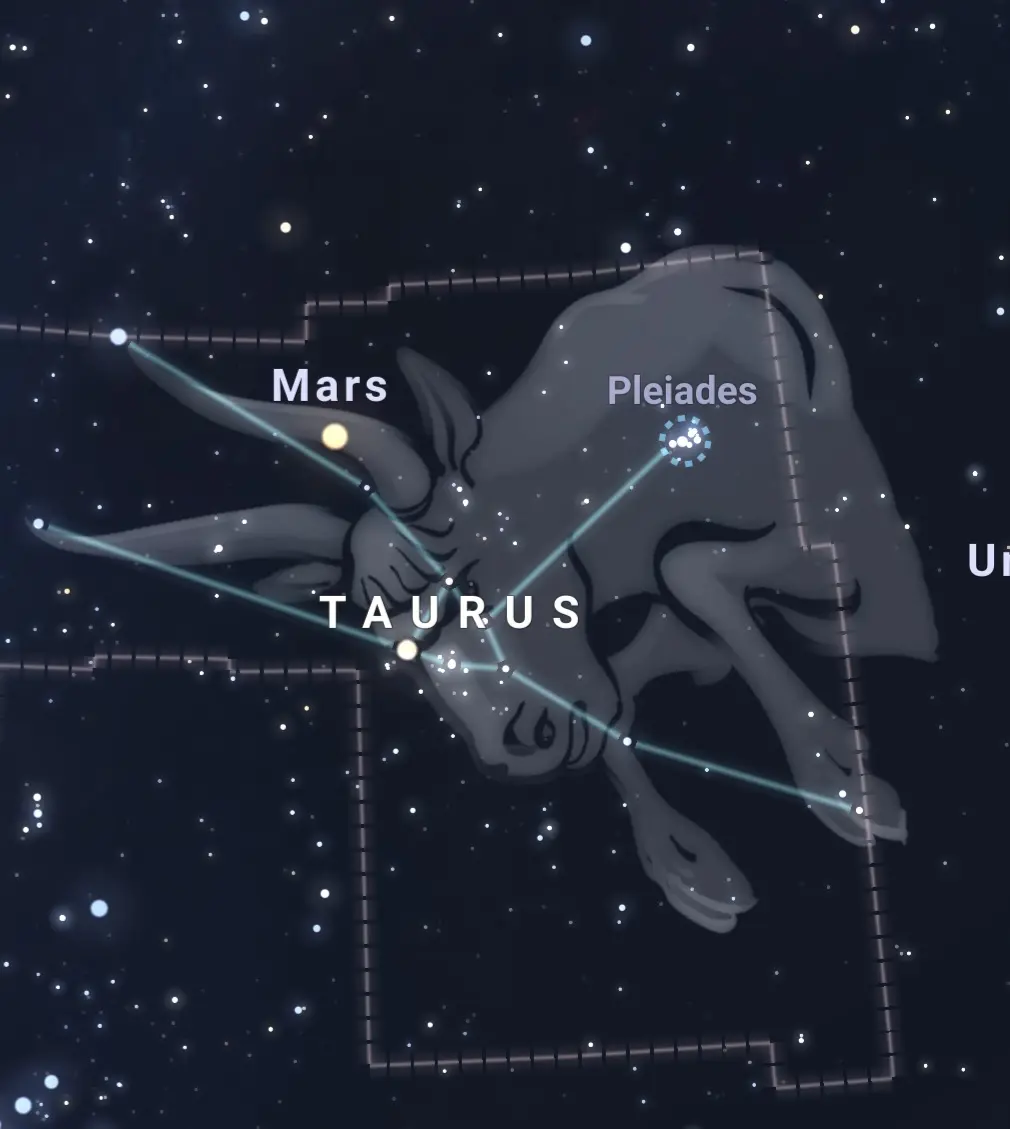
Gemini “The Twins”
Gemini means twins in Latin and the constellation is associated with the Greek mythological twins Castor and Pollux, the two anchor stars in the constellation (Note: Castor is actually a system of six stars that appear as one). Castor and Polydeuces, or Pollux (the Latin form), were “twin” brothers in Greek mythology born to Queen Leda of Sparta. Castor was son of the King of Sparta, but Pollux was son of Zeus. However, other twins are often used in other cultural associations with the constellation such as the mythological Remus and Romulus who found Rome. In Babylonian astronomy, the stars were known as the Great Twins, named Meshlamtaea and Lugalirra, “The One who has arisen from the Underworld” and the “Mighty King”.
Gemini is 30th in terms of size amongst the 88 constellations, taking up 514 square degrees in the northern hemisphere’s second quadrant and best seen in the winter months from the northern hemisphere. Bordered by Taurus to the west and Cancer to the east, Gemini’s stars create a skinny omega symbol in the night sky with Pollux and Castor at the top. You can imagine it as the twin’s stick figures side by side with the stars Castor and Pollux as their eyes and the curls at the bottom being their feet. Find Gemini by locating Orion’s Belt, moving down to the bright blue star Rigel in his right foot, then up again through the belt towards red Betelgeuse in Orion’s left shoulder, and continue until you spot Castor and Pollux. The horns of Taurus also point to Gemini. It is visible in the northern hemisphere from November through April.
With a telescope, you can distinguish two, maybe three stars in Castor, but each one is actually a double star, only visible in very high-powered telescopes. Pollux and Castor are the brightest at 1.14 and 1.58 magnitudes respectively and two more at less than magnitude 3. You’ll likely see Castor and Pollux even in bright locations, but from a reasonably dark site, about a dozen stars can be visible in the constellations.
Messier 35 (NGC 2168) is an open cluster of 100 stars that can be seen with binoculars. The Medusa Nebula (Abell 21) is a faint planetary nebula that formed when a red giant star transitioned into a white dwarf. There are other deep sky objects, but they are only visible with large telescopes. NGC 2392 is a planetary nebula with a fantastic spherical shape known by several nicknames, but is currently most famous as one of the nicknames that are currently being reexamined for insensitive language.
Gemini is also the observed origin point of the Geminid meteor shower, one of the best annual meteor showers with 120 meteors per hour during its peak. This shower occurs between November 19th and December 24th with the peak around December 14th. The shower is caused by Earth passing through the debris trail of an asteroid, but appears to emanate from Gemini.
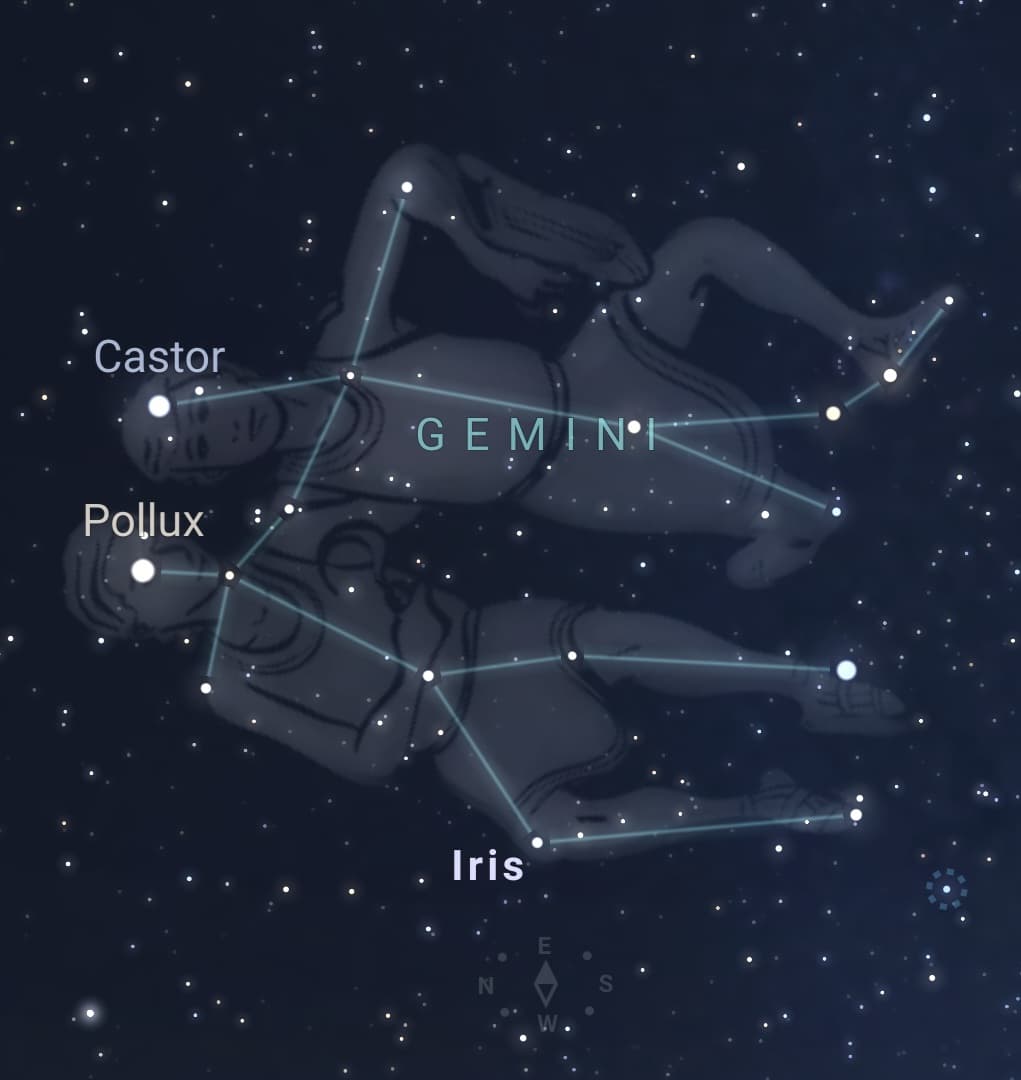
Cancer “The Crab”
Latin for “crab”, Cancer is the dimmest of the zodiac constellation with only two stars above the fourth magnitude. It lies between Leo the Lion and Gemini the Twins. Connecting the stars creates a faint, upside-down Y. It is visible from the Northern Hemisphere in early spring and during autumn in the Southern Hemisphere, March. It occupies an area of 506 square degrees, ranking 31st.
The brightest star in Cancer is Beta Cancri or Altarf “End or Edge” at magnitude 3.5, an orange-hued star about 290 light-years from Earth. Acubens “the claw” is a double star, the primary of which is magnitude 4.3 at 173 light-years from Earth.
Cancer contains 2 Messier objects: M44 and M67. The most well-known of the two is M44, the Beehive Cluster, a small star cluster of about 200 stars, resembling a swarm of bees, the brightest of which are 6th magnitude. M67 is another open star cluster with other 100 stars. There are other dim deep sky objects only visible with large telescopes.
Cancer is famous for housing the exoplanet 55 Cancri e, a super-Earth whose host star was originally believed to host so much carbon that it was called a “diamond world” but subsequent observations revealed only about 25% more oxygen than carbon.
The Cancer constellation is associated with the giant crab that attacked Heracles/Hercules during the second of his twelve labors. The crab was sent by Hera during his battle with the Hydra. There are a number of different versions of how he defeats the crab. One of the most famous is that he kicks it so hard it is propelled into the star. In other ancient cultures, this group of stars was believed to be the gate souls passed through from Heaven to Earth as they are born.
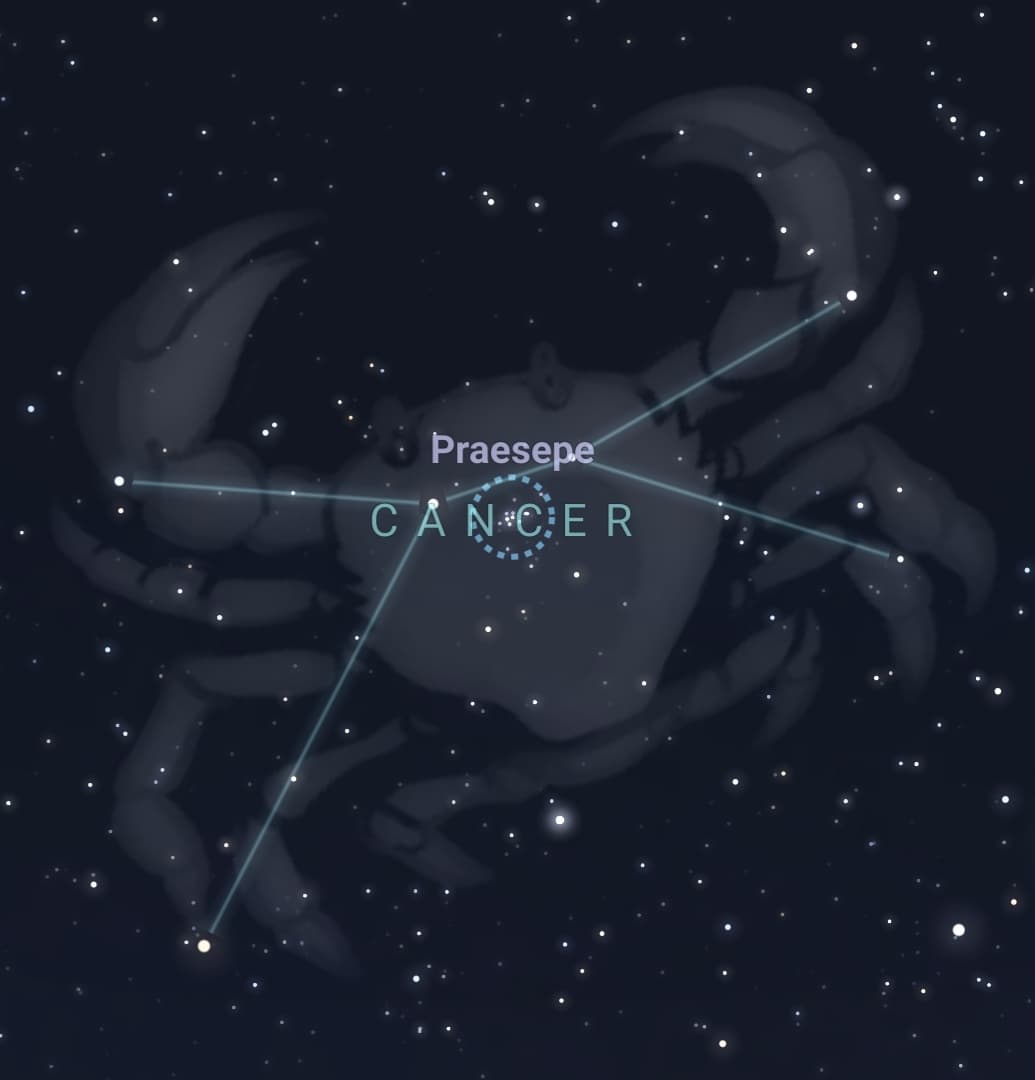
Leo “The Lion”
This constellation is one of the easiest to spot in the night sky and is visible from pretty much everywhere on Earth (except Antarctica). Its prominence in the night sky made it a common feature in myths and legends around the world. Connecting its stars creates a fairly recognizable head and mane shape, also seen as a sickle or backward question mark which combined with its haunches of a trio of stars, creates a coathanger shape. Leo is the 12th largest of all 88 constellations covering 947 square degrees. In the northern hemisphere, it is easily spied during spring, particularly around the equinox, soon after sunset and for most of the night.
Leo lies between Cancer to the west and Virgo to the east and other neighboring constellations include Hydra, Leo Minor, Lynx, and Ursa Major. The bottom tip of the sickle/backward question mark/ coathanger is the bright star Regulus (Alpha Leonis) “Heart of the Lion” which has a magnitude of 1.36. The next brightest is Algiebra “Forehead of the Lion” above Regulus at 2.1 magnitude and then Denebola “Tail of the Lion” at 2.14. There are two more stars at less than three magnitude, making this an easy constellation to spot.
In addition to the stars, there are several galaxies within Leo, including:
- the Leo triplet of spiral galaxies, a particularly popular and exciting target for astrophotographers
- M66: an intermediate spiral galaxy with
- M65: an intermediate spiral galaxy about 95,000 light-years away
- NGC 3628 which are actually gravitationally bound together around 35 million light-years from Earth.
- M95: barred spiral galaxy
- M96: intermediate spiral galaxy
- M105: elliptical galaxy with supermassive black hole at its center
In addition to these, Leo also houses the Leo Ring, a primordial cloud of hydrogen and helium gas six times wider than the Milky Way as well as a spiral galaxy called the Hamburger Galaxy (NGC 3628) in addition to others that need a large telescope to be visible.
Leo is also the radiant/ origin point for the Leonid meteor shower which occurs annually around November due to Earth passing through debris left by Comet Tempel-Tuttle.
As one of the oldest constellations in the sky, the ancient Mesopotamians likely had a constellation for it as early as 4,000 B.C. The Persians named it Shir and it was known as the Great Lion by the Babylonians. The ancient Egyptians saw it as the place where the Sun rose after creation as its appearance coincided with the summer solstice and flooding of the Nile River which provided irrigation. For the Greeks, it is the Nemean lion that Heracles/ Hercules battles in the first of his twelve labors. This lion’s golden mane protected it from any attack and its claws were sharper than any weapon made by man.
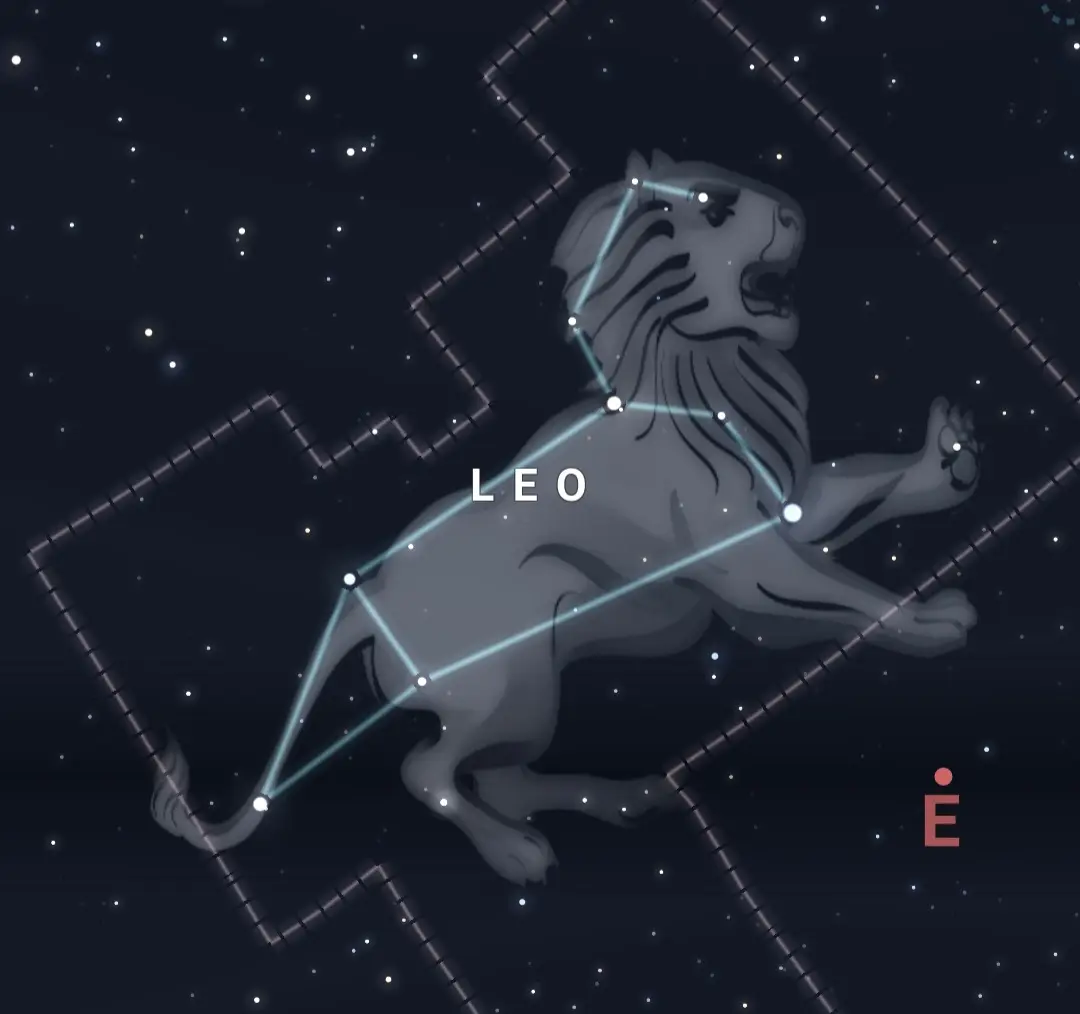
Virgo “The Virgin/ Maiden”
This largest zodiac constellation is also the second-largest of all 88 at 1,294 square degrees. Lying between Leo and Libra, it is visible in the Northern Hemisphere during spring and summer and in the Southern Hemisphere during fall and winter. Its rising in the East correlated with the start of spring in the North. The September equinox is currently located in Virgo.
One of the easiest ways to find Virgo is to start with the curved handle of the Big Dipper in Ursa Major and then “arc to Arcturus [the bright star in Bootes] and spike/ speed down to Spica [the brightest star in Virgo]”. Spica is a bright blue variable star, the name of which means “ear of grain” and has a magnitude of 0.98, making it easy to spot. While many of the rest of the stars in Virgo are faint, in a dark sky you can trace out a stick figure person with Spica as one hand and the smaller Vindemiatrix (“the grape gatherer”) as the other and then the decently bright binary system Gamma Virginis at the center, the heart.
Virgo also contains 11 Messier objects, beaten only by Sagittarius. This is mainly due to the fact that Virgo hosts the Virgo cluster of over 1,300 galaxies, located next to the Local Group which contains our Milky Way Galaxy. Some objects within the Virgo cluster are visible to the naked eye, but many are only visible with binoculars and telescopes. Some of the most popular include:
- Messier 104: dubbed the Sombrero Galaxy due to its resemblance to the hat, displaying an almost directly edge-on view from our perspective here on Earth
- M49: a massive, ancient elliptical galaxy of almost 6,000 globular clusters
- M58: a barred spiral galaxy from which two supernovas were observed in the 1980s.
- M61, M90: Spiral galaxies
- The Butterfly Galaxies NGC 4567 and NGC 4568: create a butterfly shape from their slow collision
- M87: one of the most massive galaxies in our neighborhood and the second brightest galaxy in Virgo, is home to the first supermassive black hole ever photographed in 2017 by the Event Horizon Telescope. This black hole is named Pōwehi, meaning “embellished dark source of unending creation” in Hawaiian.
- M59, M60, M84, M86, M89: Elliptical Galaxies
Virgo is also the site of several exoplanet finds including GJ 504b, the first planet discovered around a pulsar, and WASP-39b which contains the James Webb Space Telescope’s first detection of carbon dioxide in an exoplanet atmosphere.
While not typically brilliant enough to make the list of most popular annual meteor showers, there are a number of meteor showers in the Northern hemisphere’s spring whose radiant or origin point is Virgo, collectively called the Virginids. They include:
- Pi Virginids: February 13 to April 8, peak approx. March 3
- Eta Virginids: February 12 to March 27, peak approx. March 18
- Theta Virginids: March 10 to April 21, peak approx. March 30
- Alpha Virginids: March 10 to May 6, peak approx. April 7
- Mu Virginids: April 1 to May 12, peak approx. April 24
Virgo is often associated with a variety of maidens in mythology, but most often with two today. The first is Persephone, the Greek queen of the underworld, wife to Hades who is responsible (in conjunction with her mother Demeter) for the seasons which correlate to when she is in the underworld. The second maiden from Greek mythology which is often associated with the constellation Virgo, is Dike, the goddess of justice who is said to hold wheat in one hand. This ancient constellation has similar interpretations in other cultures. Ancient Baylonians called it “The Furrow” which represented the goddess Shala’s ear of grain. The ancient Romans used it to depict Ceres. Virgo was also sometimes associated with the virgin goddess Astraea, holding the scales of justice represented by the Libra constellation. Virgo is often depicted on charts as a maiden with wings holding two ears of wheat, one of which is marked by Spica.
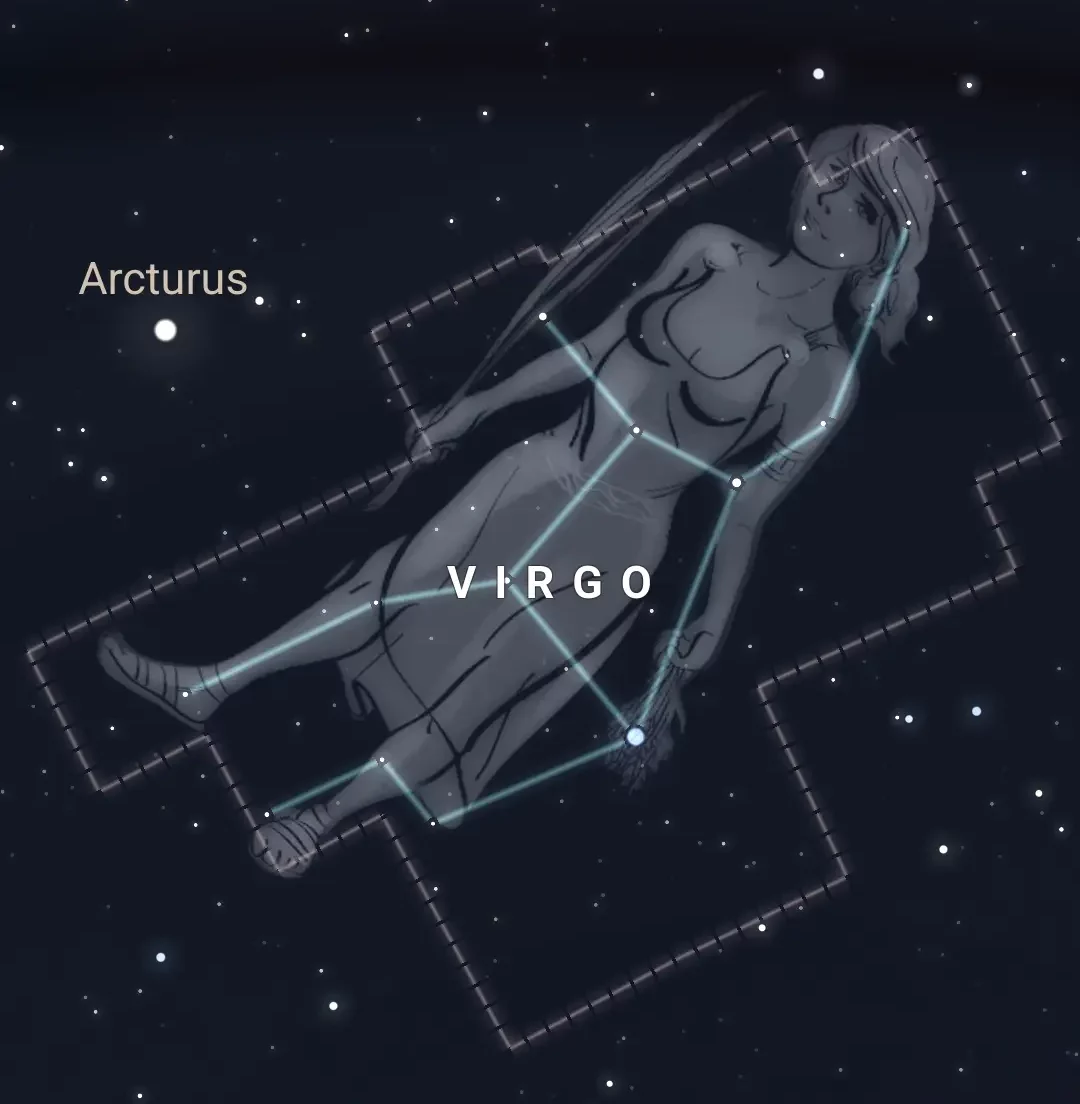
Libra “The Scales”
Libra is the only zodiac constellation not named after mythological animals or people, but instead is Latin for the weighing scales. This constellation from the southern sky has impacted various cultures, often being associated with .harmony, balance, and justice. Spanning 538 square degrees, it ranks 29th among all 88
Libra is located in the Southern Hemisphere in the winter and the Northern Hemisphere in the summer, best seen in the latter during late spring and early summer after 9 pm. It is located between Scorpius to the east and Virgo to the west, but also borders Hydra, Centaurus, Lupus, and Ophiuchus. The sun appeared during the autumnal equinox in Libra until 729 B.C.E. when the Earth’s precession began to slowly shift the equinox to Virgo. The autumnal equinox will shift to Leo in 2439.
Most of the stars in Libra are faint, but the brightest star is Zubeneslchemali (“northern claw”) or Beta Librae (β Lib) or Lanx Australis (“the southern scale”) in the upper part of the scale, linking the two balances, a blue dwarf star 160 light-years away with a magnitude of 2.6. The two next brightest stars hang beneath β Lib from the triangle. Alpha Librae (α Lib) or Zubenelgenubi (“southern claw”) is a binary star 77 light-years from Earth and Gamma Librae (γ Lib), is an orange giant at magnitude 3.9 about 152 light-years away.
There are no Messier objects in Virgo, but there are a few dim deep sky objects that require a large telescope to view. NGC 5897 is a globular star cluster 40,000 light-years from Earth. The constellation also contains HD 140283, better known as, Methuselah, one of the universe’s oldest stars with modern estimates at about 14.46 billion years old, give or take about 800 million years making it about as old as the universe itself. In addition, there is the barred spiral galaxy, NGC 5792, the lenticular galaxy NGC 5890, and the spiral galaxy NGC 5793.
This constellation goes back to the ancient Babylonians who saw it as the Balance of Heaven. Many cultures actually combined it with neighboring constellations. The ancient Greeks considered these stars to be part of Scorpius, representing the claws. This explains the names of Zubenelgenubi and Zubeneschamali. The Romans originally saw it as the golden chariot of Pluto, god of the underworld but later reintroduced the scales connotation with this group of stars, depicting it as the scales of justice held by the constellation Virgo who represented the Greek goddess of justice Astrea with Zubenelgenubi and Zubeneschamali symbolizing divine justice. In addition, the constellation was also associated with the balance of seasons and day and night by the ancients.
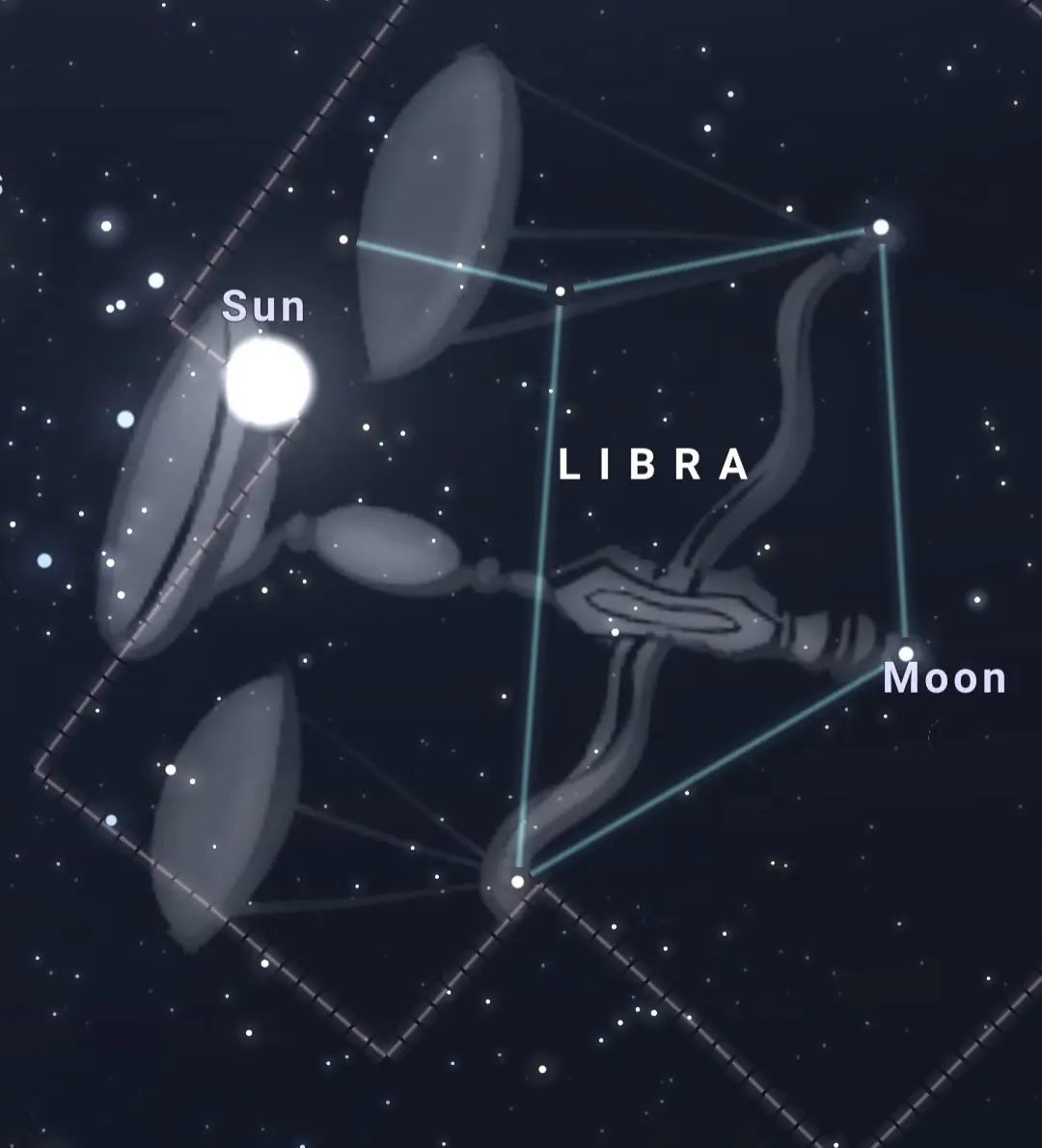
Scorpius/ Scorpio “The Scorpion”
This is one of the brightest and most recognized constellations in the night sky. Scorpius is Latin for “creature with the burning sting” and is the root of our more modern name of scorpion for this creature. Spanning 497 square degrees, ig ranks 33rd out of the constellations. Between May and August, some or all of Scorpius is visible from both the Southern Hemisphere and the mid-Northern Hemisphere, appearing high in the sky in the center of the Milky Way in the former and closer to the southern horizon in the latter. July and August are typically the best months to see this easily spotted constellation with an unusual shape (a distinct J shape often described as either a stinger or a fishhook) and decent brightness.
The brightest and most famous is the red giant Antares with a magnitude of 0.96, which means “not Mars” of “Rival of Mars” as it is often mistaken for our red planet. Shaula “Raised Tail” and Lesath “Poisonous Bite” int he tail are sometimes called “Cat’s Eyes” for their close proximity to each other. A total of 14 stars have detected exoplanets, one of which is also nicknamed Methuselah for its extreme age, an estimated 12.2 billion years old (plus or minus 1 billion years). Some of the exoplanets are within the habitable zone of their star including some around the red dwarf Gliese 667c.
Since it is close to the center of our view of our Milky Way galaxy, it contains many popular astronomical objects, some visible with the naked eye, but many are best viewed with either a good set of binoculars or a telescope. Messier objects include:
- Messier 6/ NGC 6405/ the Butterfly Cluster: an open star cluster that features a vague resemblance to the butterfly with its 80 stars
- Ptolemy’s Cluster (NGC 6475 or Messier 7): an open cluster of about 80 stars easily seen with the naked eye or binoculars named as such because it was cataloged by the Greek astronomer and mathematician.
- “Cat’s Eye” (Messier 4 or NGC 6121): the closest globular cluster to Earth lies near Antares meaning it can be seen faintly with the naked eye, but binoculars or a small telescope is recommended. In general, this cluster is home to some of the oldest astronomical objects known including the exoplanet Methuselah previously mentioned.
- Messier 80: one of the densest globular clusters in the Milky Way with hundreds of thousands of stars and can be spotted with a small telescope, most easily in July. A larger percentage than expected of its stars are very young and massive.
Other deep sky objects include:
- The Bug/ Butterfly Nebula (NGC 6302 or Caldwell 69) features beautiful wings visible in about 3-inch (80mm) binoculars or a small telescope. This planetary nebula features a bipolar/ hourglass (butterfly in this case) shape which occurs when the material is funneled toward the star’s poles. features a similar but more.
- The Cat’s Paw Nebula (NGC 6334): an emission nebula where new stars are being formed.
- War and Peace Nebula (NGC 6357): diffuse nebula forming stars
Both the annual Alpha Scorpiids and Omega Scorpiids meteors showers seem to originate in Scorpius (from the stars Alpha Scorpii, Antares, and Omega Scorpii respectively). The first happens during the month of May every year, peaking on the 16th with about 5 meteors per hour. The latter takes place from May 23 to June 15 and is divided into the North and South Omega Scorpiids meteor showers, depending on which hemisphere they are visible from, both peaking around June 2nd. Similar to the Alphas, the peak is about 5 meteors an hour.
Scoripius is closely associated with Orion in Greek mythology as it was sent either by a jealous Artemis or by the Earth itself for Orion’s boast that he could kill any animal in the world. In both, Zeus placed Scorpius among the stars after it won the battle. While they are both constellations, they are never seen in the sky together because Scorpius rises in the East after Orion sets in the West.
While it is one of the most recognized groups of stars, it is not always depicted as a scorpion, primarily in cultures that do not have these creatures. In Chinese mythology, it is part of the Azure Dragon while the Javanese people in Indonesia named it Banyakangrem “the brooded swan” or Kalapa Doyong “leaning coconut tree”. In Hawaii, it is the demigod Maui’s Fishhook, made more popular in recent times by the Disney film Moana.
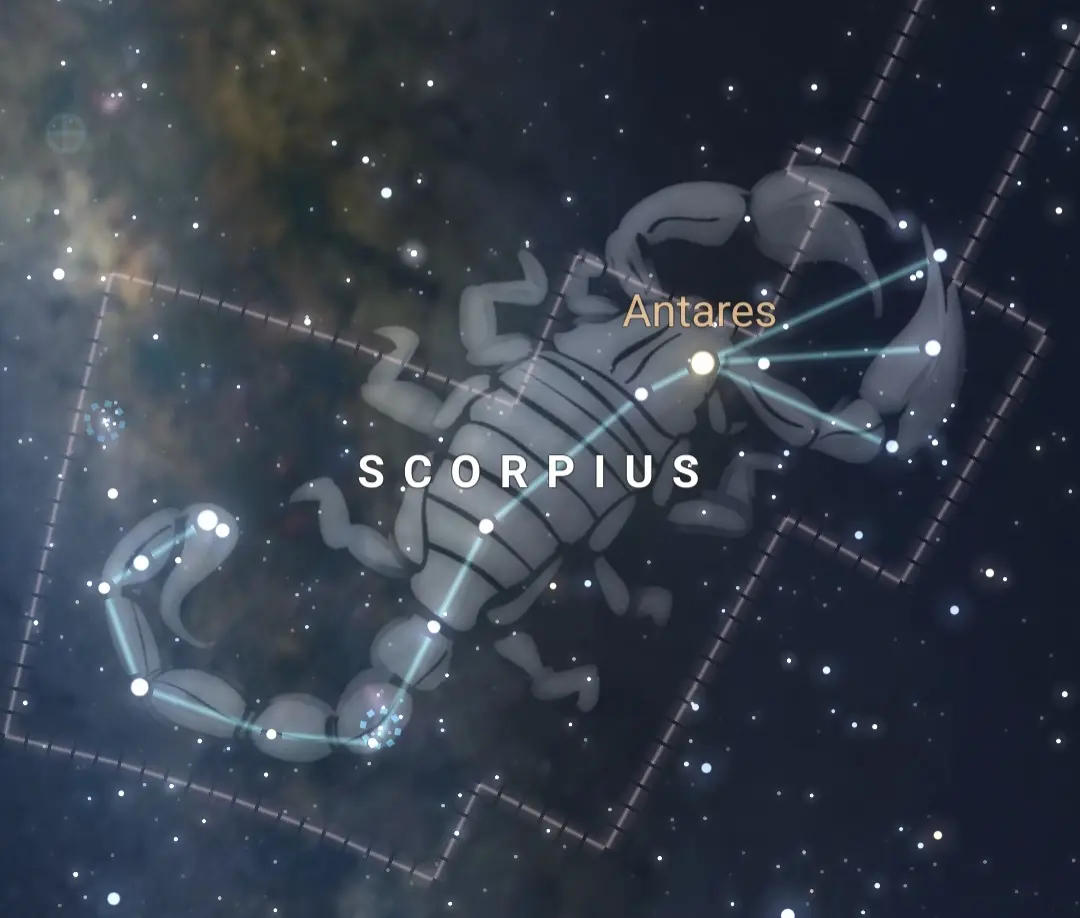
Sagittarius “The Archer”
At 867 square degrees, Sagittarius (meaning “archer” in Latin) is the largest constellation in the Southern Hemisphere and the 15th largest overall, featuring bright stars and easily spotted with the naked eye, especially by finding the teacup asterism. Located directly at the center of the Milky Way from our perspective, at its densest point. It borders, Capricornus, Scorpius, Aquila, Scutum, Serpens Cauda, Corona Australis, Telescopium, Indus, and Microscopium. It is best viewed in August.
Sagittarius features seven stars below magnitude 3. Epsilon Sagittarii (Kaus Australis for southern bow) is the brightest in the constellation and the 36th brightest star in the sky at a magnitude of 1.85. Next is Nunki with a magnitude of 2.05 and finally Ascella “Armpit” with a magnitude of 2.59. Together, they and a few others form an asterism that resembles a teapot and Delta, Epsilon and Lambda Sagittarii create the archer’s bow. The star at the top of the Teapot, Lambda Sagittarii (Kaus Borealis, or northern bow) is the fifth brightest star.
Sagittarius points to the center of the Milky Way, meaning that the supermassive black hole (Sagittarius A) at the center of our galaxy actually lies within this constellation from our perspective, detectable through its radio wave emissions and how it affects stars around it.
It contains more Messier objects than any other constellation with 15 in all including seven globular clusters, four open star clusters, and three nebulae. Some of the most famous include:
- Lagoon Nebula/ Messier 8/ NGC 6523: a famous large interstellar cloud 50 by 110 light-years across
- Omega or Swan Nebula/ Messier 17/ NGC 6618: an emission nebula over 5,000 light-years away
- Trifid Nebula/ M20/ NGC 6514: a nebula famous for its dark dust lane
- M22/ the Sagittarius Cluster: globular cluster containing over 80,000 stars and is one of only four globular clusters known to contain a planetary nebula
There are a number of other non-Messier deep sky objects including NGC 6818, a planetary nebula also known as the Little Gem Nebula. The first globular cluster discovered outside of the Milky Way is also located in this constellation: the Sagittarius Dwarf Elliptical Galaxy.
This constellation originated as the Babylonians’ god of war, but is more well known for its Greek mythology origin: the centaur (half man and half horse) archer, but little is known of his origins. The constellation is aiming an arrow toward the heart of Scorpius. However, there can be confusion due to another centaur, Chiron, who is the inspiration for the Centaurus constellation. In Babylonia, this constellation was associated with the god Pabilsaĝ who was sometimes called “the wild bull with multicolored legs” and featured a human head, a panther head, and wings.
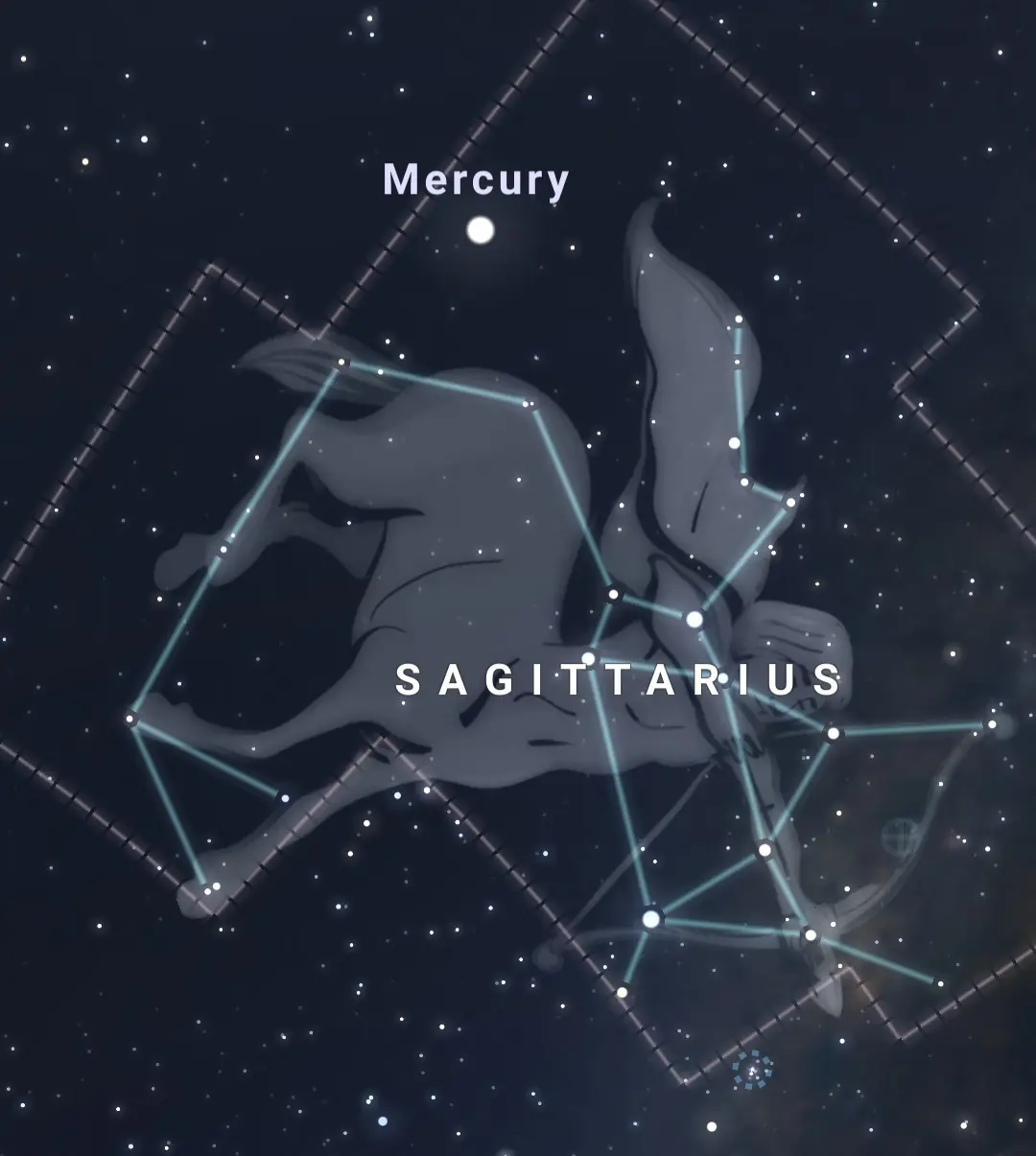
The thirteenth zodiac constellation: Ophiuchus “The Serpent/ Snake Bearer”
Located between Scorpius and Sagittarius (to the west and east respectively), this fairly large constellation has long been omitted from the list of zodiac constellations because when these were invented by the Babylonians 300 years ago, it did not lie on the ecliptic as it does now, with the Sun passing through it every December. It was, however, cataloged by Ptolemy in the second century with the other 48 ancient constellations. In 2011, it was added as an astrological sign, causing a realignment of the Zodiac calendar.
Spanning 948 square degrees, Ophiuchus is the 11th largest constellation and is located northwest of the center of the Milky Way and near Aquila, Serpens, and Hercules, opposite Orion. It is best viewed in summer in the northern hemisphere and winter in the southern hemisphere, particularly in July.
Ophiuchus actually contains the second closest star to Earth, Barnard’s Star, at only about 6 light-years away. Despite being so close, it is hard to spy with the naked eye since it is a red dwarf with a magnitude of 9.5. At the head of Ophiuchus is the brightest star, Alpha Ophiuchi, an A-type giant star also known as Rasalhague “Head of the Snake Charmer” in Arabic with a visual magnitude of 2.07. Other notable stars include the knees of Ophiuchus – Eta Ophiuchi and Zeta Ophiuchi – and the left arm Delta Ophiuchi (Yed Prior) and Epsilon Ophiuchi.
Ophiuchus houses a number of popular astronomical targets, including 7 Messier objects, all of which are globular clusters. There are several star clusters, including most notably Messier 10 at only 20,000 light-years away with a magnitude of 6.6. Kepler’s Supernova/ Kepler’s Star/ Supernova 1604 is also housed in Ophiuchus. It was discovered in 1604 by the astronomer Johannes Kepler (whose name was also given to the famous exoplanet-hunting telescope and the exoplanets it discovered). A popular target for astrophotography is the star nursery nebular complex Rho Ophiuchi 460 light-years away in the Serpent Bearer. It also houses exoplanet Wolf 1061c, a potentially habitable rocky planet only 13.8 light-years away.
The ancient Babylonians associated it with their serpent-god Nirah who was sometimes portrayed a human upper body, but with serpent legs. The ancient Greeks saw Apollo struggling with the giant snake that guarded the Oracle of Delphi in this constellation. Later, the Greeks linked it with Asclepius (son of Apollo) who was said to be able to resurrect people from the dead, knowledge possibly learned from snakes. Ophiuchus is often associated with healing as snakes are often associated with doctors, even being featured in the modern symbol for medicine.
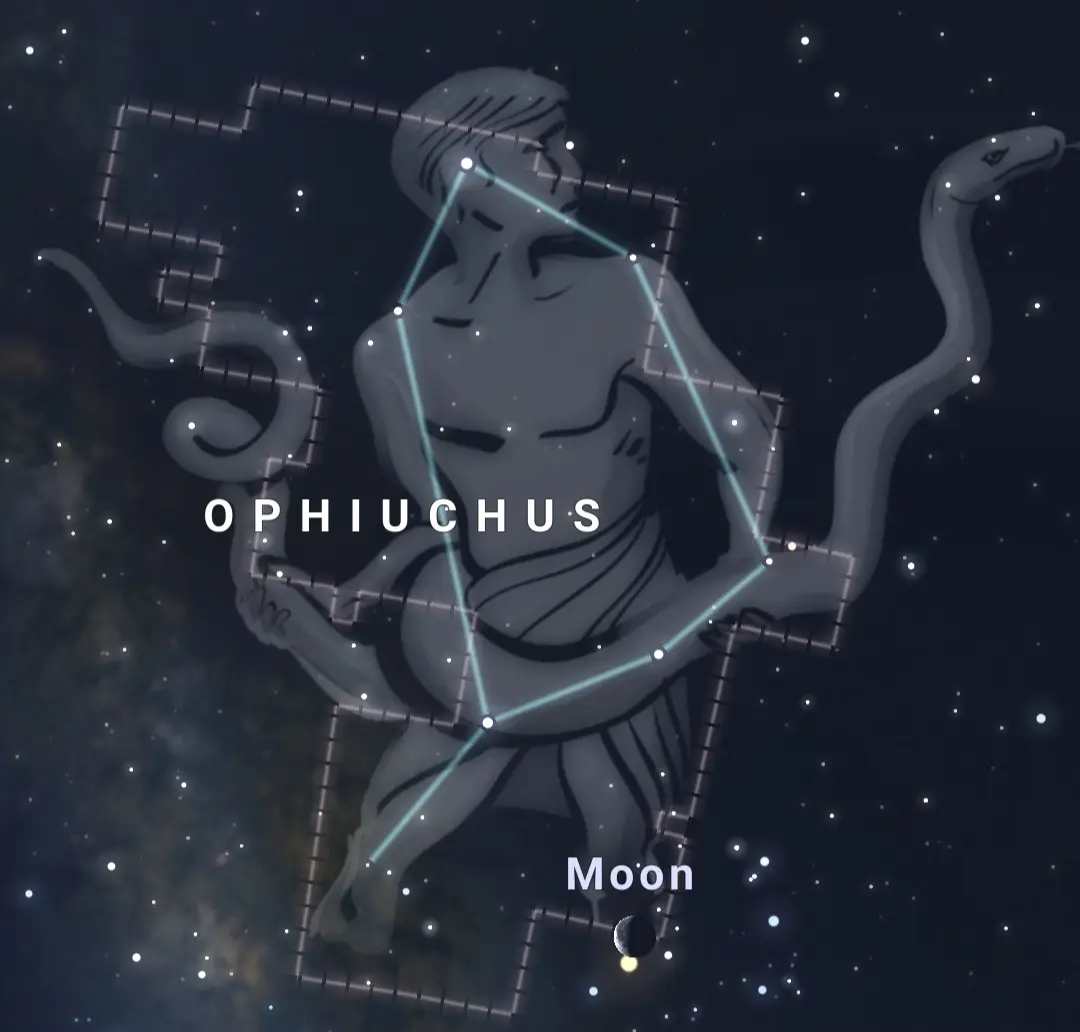
Conclusion
While many stars and constellations fascinate us, the zodiac constellations have fascinated peoples around the world for thousands of years, intertwining into our cultures, mythology, and annual rituals.
While typically numbered at 12, there is a thirteenth that falls within the ecliptic band of the sky that our Sun travels through. These are all fascinating constellations with objects of interest, even if they may not be the largest or brightest.

Sarah Hoffschwelle is a freelance writer who covers a combination of topics including astronomy, general science and STEM, self-development, art, and societal commentary. In the past, Sarah worked in educational nonprofits providing free-choice learning experiences for audiences ages 2-99. As a lifelong space nerd, she loves sharing the universe with others through her words. She currently writes on Medium at https://medium.com/@sarah-marie and authors self-help and children’s books.
Wow! There's more to read 🚀
This constellation-related story is part of our collection of stargazing articles. If this piece sparked your interest, you’re sure to enjoy the fascinating insights offered in our subsequent articles.



